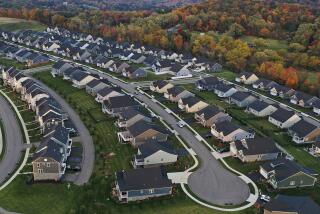CALIFORNIA ELECTIONS GOVERNOR : The Promise of a Dream, a Show of Concern for Latino Residents : Feinstein: The Democratic candidate appeals to young Californians who want own homes.
- Share via
SAN FRANCISCO — Dianne Feinstein promised Thursday that if she is elected governor she will revive the dream of homeownership for young Californians.
She also talked of building whole new towns along a proposed railroad line through the Central Valley.
Feinstein showed off some of the new housing built in pricey San Francisco for low-income families and first-time homeowners under programs inaugurated by her administration as mayor.
“Now it’s time to bring that same energy, that same commitment, that same leadership to the state of California,” the Democratic candidate for governor said in the auditorium at the new Delancey Street housing complex across from Pier 36 on San Francisco’s Embarcadero.
Feinstein then visited the three-bedroom, 1,200-square-foot Parkview Commons townhouse bought by architect David Rulon for $140,000 even though the unit and others like it have been appraised for as much as $400,000.
Under her administration, the city and a nonprofit development firm built 114 townhouses that were offered for sale to first-time home buyers making $40,000 or less a year. Rulon was one of 3,271 applicants who entered a lottery to buy the units, which were priced as low as $99,000.
Until the chance to buy into Parkview came along, Rulon said, he and his wife had considered moving from the San Francisco Bay Area, perhaps to Seattle. “This was our one and only opportunity to buy something in the Bay Area,” Rulon told reporters who toured the unit with the candidate and her entourage.
Feinstein said Parkview is just one of a variety of housing concepts that California needs so that less-affluent residents, seniors and others can afford to own their own homes.
“It’s like a savings account,” Feinstein said of home ownership. “There’s nothing better and it’s so hard for young families.”
Feinstein also said, in response to a question, that while she would propose some changes in Proposition 13, the property tax-cutting initiative approved in 1978, she would not tamper with the Jarvis-Gann 1% property tax rate limit, calling it “inviolate.”
“People live in a fear that the property taxes, if they can’t work, would become such that they would lose their homes,” she said. “I think that’s an extremely emotional issue. That’s what brought on Proposition 13 in the first place. We must protect that rate for residential property taxpayers . . . who want their homes for their family housing and they deserve to be protected.”
Feinstein said California had suffered under eight years of Republican neglect of the housing issue. She said that only 10% of $600 million worth of voter-approved housing bonds have been spent.
“It will become an immediate priority of mine to see that those funds are turned into housing units as quickly as possible,” she said.
Feinstein also said that voter approval of highway and rail construction funds in June offers the opportunity for the sort of innovation she said is needed to avoid traffic congestion, end long commutes by workers who cannot afford to live near their workplaces, and to manage California’s growth.
“We have a chance to begin that rail spine down California, to begin some new towns and do it right with jobs close to housing and use some innovative methodology to build some new homes,” she said.
For Feinstein, Wednesday and Thursday provided the most sustained public campaigning she had done in her home city since her primary election victory June 5. She hugged old friends and associates arriving at Delancey Street on one of those sunny, wind-swept days for which the city is famous.
“It’s wonderful to be home,” she said, and remarked about the smog and traffic congestion in the Los Angeles area.
The genesis of Parkview Commons was the San Francisco school board’s decision back in the 1970s to abandon a high school building because of earthquake hazards. The city put up $2.5 million to lease the site from the school district for 75 years and paid $1 million to demolish the old school buildings. The use of tax-exempt bonds financed mortgage funds at fixed below-market interest rates.
The start-up city funds came from the city’s Office of Affordable Housing Production Program, which received $30 million from downtown office building developers as part of what Feinstein said was “an obligation to help provide affordable housing” in the city.
Feinstein said the city built an estimated $500 million worth of affordable housing under such programs during the first seven years of her administration or “nearly half of all housing developments in San Francisco during those years.”
“It’s innovation that builds housing today,” she said.
More to Read
Get the L.A. Times Politics newsletter
Deeply reported insights into legislation, politics and policy from Sacramento, Washington and beyond. In your inbox twice per week.
You may occasionally receive promotional content from the Los Angeles Times.










